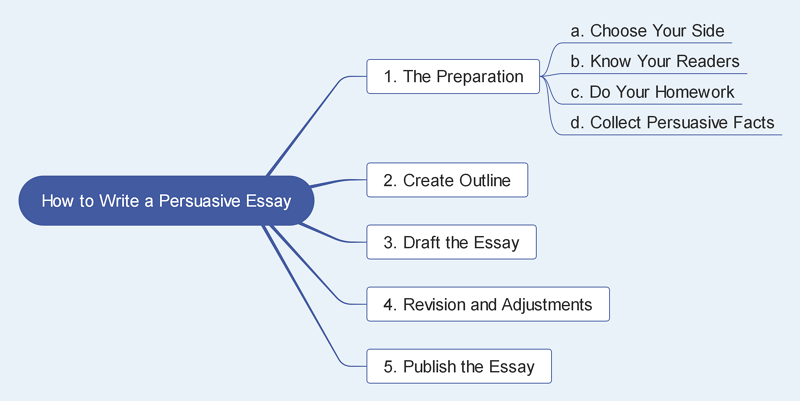How to Write a Perfect Persuasive Essay
Unlike typical essays that inform the readers about something or elaborate on a specific subject, persuasive essays use a more stubborn tone to persuade the audience to believe in the correctness of the author's viewpoint. Therefore, to learn how to write a persuasive essay, a different approach is required altogether, and this is what you will learn in the following sections.
Introduction of Persuasive Essay
A persuasive essay reflects the opinions of the writer on a particular topic, and the content it has either discusses ‘for’ the subject or ‘against’ it. This is like a text version of a debate that the children have in schools where they are given a theme, and split in two teams. One of those teams is supposed to talk in favor of the topic, while the other needs to oppose it.
However, unlike the verbal debates, persuasive essays contain well-researched content that sometime accompany with a reference or link to a reliable and supporting source to validate the facts.

How to Organize Your Persuasive Essay
The first step in learning how to write a persuasive essay requires you to understand how to draw an outline of the piece you are about to pen. Therefore, in this section, you will learn the process of preparing a structure of a persuasive essay, regardless of the topic you are planning to write on.
The outlines of such an essay must have:
- The Introduction
The introduction of the subject in question is essential and therefore the opening paragraph must contain some interesting points that can persuade the audience to continue reading the essay. Make sure that this introductory passage is not too long to make the readers lose their interest. Also, the last line of the subsection must give a clear hint of your opinion so the audience should know what they are about to read.
- The Body
Depending on the topic, the ‘Body’ of a persuasive essay may comprise multiple paragraphs, where each of those passages should focus on one point of the subject. In addition, every part should also contain at least one supporting link or reference to compliment the point.
- The "Against" Paragraph
This is another section in the ‘Body’ of the essay that discusses the ‘against’ aspect of the topic in question. This paragraph should mention key points to refute the subject, and to persuade the readers to believe in the rightness of the author’s point of view.
- The Conclusion
The concluding paragraph should be kind of a recap about everything you discussed in the ‘Introduction’ and the ‘Body’ sections of the essay. This passage should also contain a few links or references to support the author’s viewpoint.
How to Write Your Persuasive Essay
After understanding the process of preparing the outlines, it is time to learn how to write a persuasive essay. The following step-by-step guide shows the process to do so:
Step 1: The Preparation
This step requires you to do a couple of things, including:
- Choosing a Side
Since you are required to convince the readers for or against the subject in question, it is imperative to pick your side. Ensure to follow your instinct as to what your opinions about the topic are, and choose accordingly.
- Know Your Readers
Depending on the subject you are planning to write a persuasive essay on, make sure to understand what kind of audience you are about to address. This would help you come up with a better, more engaging content for the essay.
- Do Your Homework
The term ‘Homework’ here means thorough research that you must do before starting. With incomplete information, you are likely to end up writing an unimpressive essay that may fail to serve its purpose.
- Collect Persuasive Facts
While researching, make sure to take note of all the links and references you come across, and use them throughout your essay to support your points in order to persuade the readers.
Step 2: Create an Outline
The next step is to prepare an outline for the essay. You can follow the method explained in Part 2 to learn how to create them. The outlines help you draft the content in a proper and correct sequence, thus making the thesis more persuasive.
Step 3: Draft the Essay
This is the point where you are required to write the essay. You can use the details you gathered in Step 1 and Step 2, and draft a decent and information-enriched persuasive essay to convince the target audience as how you part is correct, and the opposition is otherwise. During creation, it is important to add the references and links to support your points wherever needed. It is also advisable to compliment your writing with some mind mapping diagrams that can be drawn using one of the easiest, most efficient, and free tools, EdrawMind (https://www.edrawmind.com/).
Step 4: Revision and Adjustments
After you are done drafting, it is now time to re-read the essay for proofreading, re-consider the organization of the points you covered, review the sentences for any grammatical errors, re-check the words for any spelling mistakes, and make any changes that you feel could be necessary to give the entire piece a professional finish.
Step 5: Publish the Essay
Once all the elements are in their corresponding and correct place, you can safely publish the essay to a forum or portal where it can reach the target audience. At this point, you should thank every person who appreciates your thesis, and also be ready to face any criticism that people may throw upon you. While the positive feedbacks might encourage you to write more, the negative ones would teach you how to craft better and more engaging and convincing pieces in the future.
In the above sections you have learned how to write a persuasive essay in an easy manner. The step-by-step guide discussed in detail would definitely help you prepare decent and appealing drafts supported by some informative and self-descriptive mind mapping illustrations created using EdrawMind or any other equally efficient tool for your target readers.



